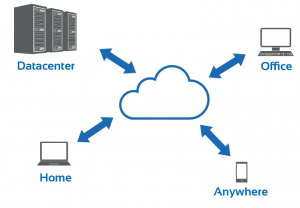
Today’s healthcare organizations have to focus on a lot more than the health of their clients. The infrastructure it takes to support clinical care delivery continues to expand, with Information Technology being one of the most significant contributors to that growth. As companies have become more dependent on technology for their clinical, administrative, and financial functions their IT departments and expenditures have had to scale quickly to keep up. This rapid growth creates a blurred line as healthcare organizations act as part healthcare provider and part technology company.
However, as technology demands have increased, so have the options for reliable infrastructure for IT applications and data storage. The one that has taken center stage over the past few years is the concept of “The Cloud.” By the end of 2018, it is expected that well more than 80% of companies will be using the cloud in some way to support their organization. So, what is it about the cloud that is so appealing? Are there advantages of cloud computing in healthcare that can propel your organization forward?

In its simplest form, the term “cloud” is a metaphor for the internet. In the past, all of your applications and software had to be on a computer or server that you could only access at a specific location. With the introduction of the cloud, people could access their programs and information using the internet as the conduit. This principle also applies to data storage. Rather than keeping folders full of critical work on your computers and servers, that data can be stored remotely and backed up to the cloud.
The ability to store documents in a place where you can access them from any device at any time is compelling. The cloud has been an innovation for companies of all sizes, causing a significant culture shift for businesses as a whole. Millions of companies around the world now use hosted or cloud services to add value to their operations, and the expectation is that this shift will only continue to accelerate in the healthcare industry over the next five years.
The adoption of cloud technology has been increasing at a frenetic pace. There are quite a few drivers for this change, but much of it comes down to a simple analysis of the costs and benefits of cloud infrastructure. For behavioral healthcare organizations, cloud computing solutions can frequently provide better levels of service as compared to their internal IT efforts. Part of this has to do with scale, but much of it is the investment in personnel, technology, rigid processes, and expertise that cloud providers can bring to healthcare IT.
Below are some of the most common advantages of cloud computing. These different levers can help guide your decisions about what type of technology should be supported in-house and what to move to the cloud.
The environment in which healthcare organizations work is ever-changing. Whether it is regulatory enhancements, financing reform, competition, or clinical quality initiatives, there are a lot of external pressures. Along with this, organizations are continually introducing (or removing) programs, locations, and staff to support their models of care. In a conventional self-hosted model, organizations are forced into the cycle of trying to keep up with hardware purchases and maintenance to support these changes.
Cloud-based services, on the other hand, allow companies to address fluctuating demands. When a need arises, it is easy to scale up the organization’s capacity with what amounts to the push of a button. Likewise, if there is a need to scale down, there is flexibility within a cloud model to do so. When every second lost affects patient safety and budget, flexibility can be a real competitive advantage.
Cost is always an essential factor in deciding where to host your applications and data. Today, healthcare companies spend upwards of 75% of their IT budgets on maintaining internal systems. While it is not always an apples-to-apples dollar comparison, there are significant differences in the cost models. Cloud computing cuts the high cost of hardware and capital expenditures. With the cloud, a company pays for a subscription service that becomes an operating expense based on their scale. It also allows organizations to divert funds into other operational areas that would have previously been used to create a robust IT infrastructure (which in many cases is underused).
With the cloud, companies can utilize the latest technology on the market. In the past, this would have been outside of many budgets and is one of the reasons a direct cost comparison is challenging. While organizations may be able to get by with lower quality hardware purchases, the ability to leverage more advanced technology for strategic initiatives from cloud service providers can help to level the playing field with their competition.
If done well, two of the cloud’s strongest features is the security and reliability that it affords an organization. While this is a strength of the cloud, security is one of the most common reasons executives do not feel comfortable moving their data and applications to servers outside of “their control.” Most of the time, this is a case of not completely understanding the concept of how the cloud works.

For example, if a healthcare provider is using a computer that happens to have protected health information on it, the loss of that equipment could potentially be a breach that could cost a company millions of dollars in penalties. If that same organization was utilizing the cloud, the computer could be remotely wiped if lost or act as a “dumb terminal” that can’t save data that doesn’t belong on it.
To further illustrate the potential of security within the cloud, the CIA made a $600 million purchase into cloud technology in 2013 to begin their shift into this new approach. The CIA’s Chief Information Security Officer made this decision because she was passionate about the advantages of cloud computing, and the ability to keep systems secure through both physical security measures and consistent system maintenance.
Along with the element of security, the cloud also can increase the reliability of data redundancy and system uptime. It does this through the automation of backups and disaster recovery options. In simple terms, this means that an organization will not lose data and will have the ability to minimize any downtime for their staff. In the case of a disaster or technology breakdown, the cloud option can provide multiple avenues to keep an organization up and running with almost no cutover time. In the past, agencies would have to rely on keeping an inventory of expensive backup hardware or wait for new equipment to be shipped. With the cloud, IT departments can maintain almost seamless continuity in service provision.
As the advantages of cloud computing in healthcare became apparent to our organization, we set out to pair out expertise in technology and behavioral health to good use. We exist to connect providers to the technology they deserve to support their communities. We knew that we had to find a make IT service more reliable, secure and scalable to support better care during heavier technology loads like EHRs and data analytics platforms.
Our goal in our cloud services offering is simple. We want to provide peace of mind to the under-resourced IT departments at so many healthcare organizations across the country. At Afia, peace of mind looks like the end of staff frustration over slow EHR performance, the freedom to confidently plan for the future, and world-class data security for the behavioral healthcare community.
If you have more questions about cloud computing and whether or not it is right for your organization, please feel free to connect with us.
All Thought Leadership